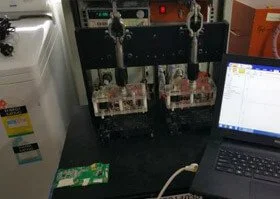PCB Screw Locking Stress Test for IPC9704 Compliance
PCB Board Screw Locking Stress Test for IPC9704 Compliance
Project Name: PCB Board Screw Locking Stress Test
In high-density electronics, the physical integrity of printed circuit boards (PCBs) is critical to product reliability. One often-overlooked factor in assembly stress comes from something as simple as a screw. During final product assembly, when a PCB is locked into position using screws, the mechanical force applied can cause localized deformation—introducing strain that may compromise the long-term performance or even the functionality of the board.
This project was designed to assess the structural stress changes and deformation caused by screw fastening in accordance with the IPC/JEDEC-9704 standard, which outlines the acceptable levels of strain on electronic assemblies.
To carry out this test, Dynatronic deployed its high-precision strain measurement system and data acquisition (DAQ) technology, enabling engineers to:
Measure real-time strain and deformation during screw locking
Identify critical points of stress concentration on the PCB
Ensure the maximum strain rate remains within IPC9704 limits
Accurate testing helps prevent mechanical overstress that could lead to:
Microcracks in solder joints
Delamination of board layers
Long-term reliability issues due to mechanical fatigue
By accurately simulating the actual assembly process and meticulously capturing strain data at every fastening point, Dynatronic equips engineers with valuable and actionable insights into potential design vulnerabilities as well as the most effective and optimal mounting strategies.
This testing is especially important in sectors where product reliability is absolutely non-negotiable—such as automotive electronics, aerospace systems, and consumer electronics—because any failure could result in significant safety risks, costly recalls, or damage to brand reputation.
At Dynatronic, we believe that great electronic design doesn’t stop at the schematic—it encompasses every detail, extending all the way down to the precise torque on the final screw.

